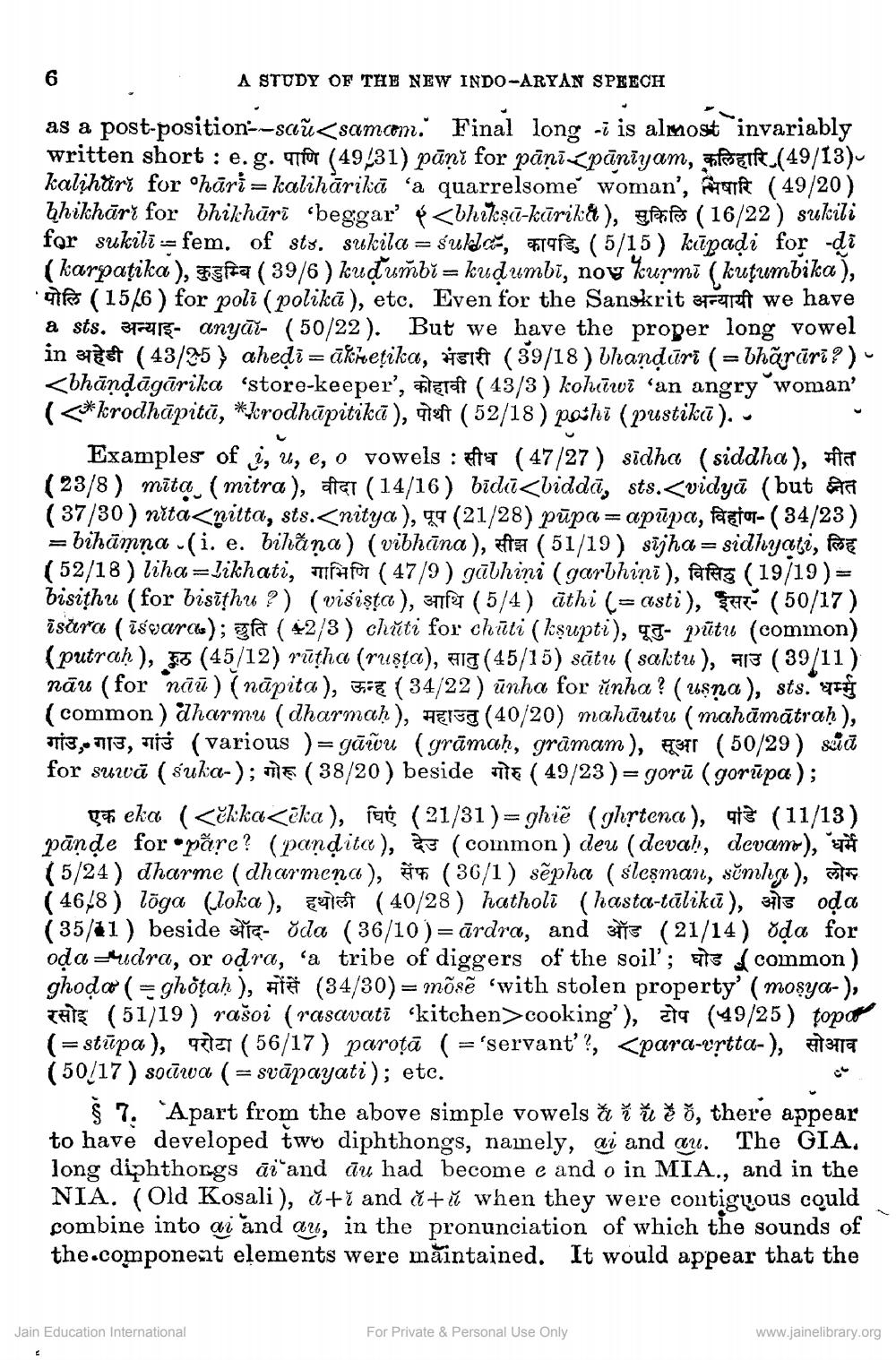________________
A STUDY OF THE NEW INDO-ARYAN SPEECH
as a post-position--saŭ<samcem. Final long -i is almost invariably written short : e.g. utfor (49431) pāņī for pāņī <pānīyam, afgif (49/13), kalihär for hāri = kalihārikā 'a quarrelsome woman', STR ( 49/20) bhikhāry for bhikhārī (beggar ý <bhikṣu-kurika), gli (16/22) sukili for sukilī -= fem. of sts. sukila = sukdom, frais, ( 5/15 ) kūpadi for di (karpaţika), sfia (39/6 ) kuļuñbi = kudumbi, now kurmi (kutumbika), difes ( 15/6 ) for poli (polikā), etc. Even for the Sanskrit orareft we have a sts. pk- anyāx- (50/22). But we have the proper long vowel in aet (43/25 ) ahedi =ākietika, isih (39/18) bhandūri ( = bhārārī?) <bhāņdāgārika “store-keeper', erat ( 43/3) kohiiwi “an angry woman' (<*krodhāpitā, *krodhūpitikā), atent ( 52/18) pathi (pustikī). -
Examples of i, u, e, o vowels : # ( 47/27) sidha (siddha), vite (23/8) mīta (mitra), atat (14/16) bidi<biddā, sts.<vidyā (but Ara ( 37/30 ) nita<nitta, sts.<nitya), 9 (21/28) pūpa=apūpa, Faetor- ( 34/23) = bihämna (i. e. bihăņa) (vibhāna), t ( 51/19) sījha = sidhyati, fare (52/18 ) liha=likhati, Tufo ( 47/9) gābhiņi ( garbhiņi), fafers (19/19)= bisithu (for bisīthu ?) (visista), 3T (5/4) äthi (= asti), kur= ( 50/17) īsára (iscarca); ga ( 42/3) chúti for chuti (ksupti), ga- pūtu (common) (putraḥ ), 7 (45/12) rūtha (ruşta), FIT (45/15) sātu ( saktu), 713 (39/11) nāu (for nãū) (nūpita), 37% ( 34/22) ünha for únha? (usna), sts. F (common) dharmu (dharmaḥ), HEIST (40/20) mahāutu ( mahāmātrah), OTİS, 713, iš (various )= gāivu (grāmaḥ, grāmam), Heir (50/29) süd for suwă ( suka-); 16 ( 38/20) beside the ( 49/23 )= gorū (gorūpa);
teka (<ěkka<ēka), sag (21/31 )= ghië (ghrtena), até (11/13) pāņde for •păre? (pandita), is (common) deu (devah, devam), (5/24) dharme (dharmena), ** (30/1) sẽpha (sleşman, sémhg), (4648) löga (loka), pellet (40/28) hatholī (hasta-tālika), 345 oda (35/11 ) beside stia- õda (36/10 )=ārdra, and its (21/14) oda for oờa=udra, or odra, “a tribe of diggers of the soil'; is common) ghoda (=ghoțaḥ), AR (34/30) = mõsē (with stolen property (mosya-), TATE (51/19 ) rašoi (rasavati kitchen>cooking'), sta (49/25) topo (= stūpa), qat ( 56/17) parotā ( ='servant?, <para-rytta-), 2477 (50/17) soñwa ( = svāpayati); etc.
Š 7. 'Apart from the above simple vowels đi ở đ č o, there appear to have developed two diphthongs, namely, ai and au. The GIA. long diphthorgs āi`and āu had become e and o in MIA., and in the NIA. (Old Kosali), đ+ and åt i when they were contiguous could combine into ai and au, in the pronunciation of which the sounds of the.component elements were maintained. It would appear that the
Jain Education International
For Private & Personal Use Only
www.jainelibrary.org




